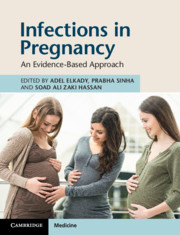Book contents
- Infections in Pregnancy
- Infections in Pregnancy
- Copyright page
- Contents
- Contributors
- Foreword
- Preface
- Section 1 Vaccination
- Section 2 Infections in Pregnancy
- Section 3 Postpartum Infections
- Chapter 29 Puerperal Sepsis
- Chapter 30 Puerperal Endometritis
- Chapter 31 Puerperal Mastitis
- Chapter 32 Breast Abscess
- Chapter 33 Pelvic Inflammatory Disease
- Index
- References
Chapter 30 - Puerperal Endometritis
from Section 3 - Postpartum Infections
Published online by Cambridge University Press: 11 October 2019
- Infections in Pregnancy
- Infections in Pregnancy
- Copyright page
- Contents
- Contributors
- Foreword
- Preface
- Section 1 Vaccination
- Section 2 Infections in Pregnancy
- Section 3 Postpartum Infections
- Chapter 29 Puerperal Sepsis
- Chapter 30 Puerperal Endometritis
- Chapter 31 Puerperal Mastitis
- Chapter 32 Breast Abscess
- Chapter 33 Pelvic Inflammatory Disease
- Index
- References
Summary
Endometritis refers to infection of the decidua (endometrium). The infection may also extend into the myometrium (endomyometritis) or involve the parametrium (parametritis).
Commonly isolated organisms include Ureaplasma urealyticum, Peptostreptococcus, Gardnerella vaginalis, Bacteroides bivius and group B Streptococcus.
Chlamydia has been associated with late-onset postpartum endometritis.
Enterococcus is identified in up to 25 per cent of women with puerperal endometritis.
Ascending infection from the vagina is the main mechanism.
The highest incidence is during childbirth: 1–3 per cent of vaginal births, and up to 27 per cent of caesarean births. In the USA the incidence after caesarean section ranges from 13 to 90 per cent, depending on the risk factors present and whether perioperative antibiotic prophylaxis had been given.
- Type
- Chapter
- Information
- Infections in PregnancyAn Evidence-Based Approach, pp. 180 - 182Publisher: Cambridge University PressPrint publication year: 2019

